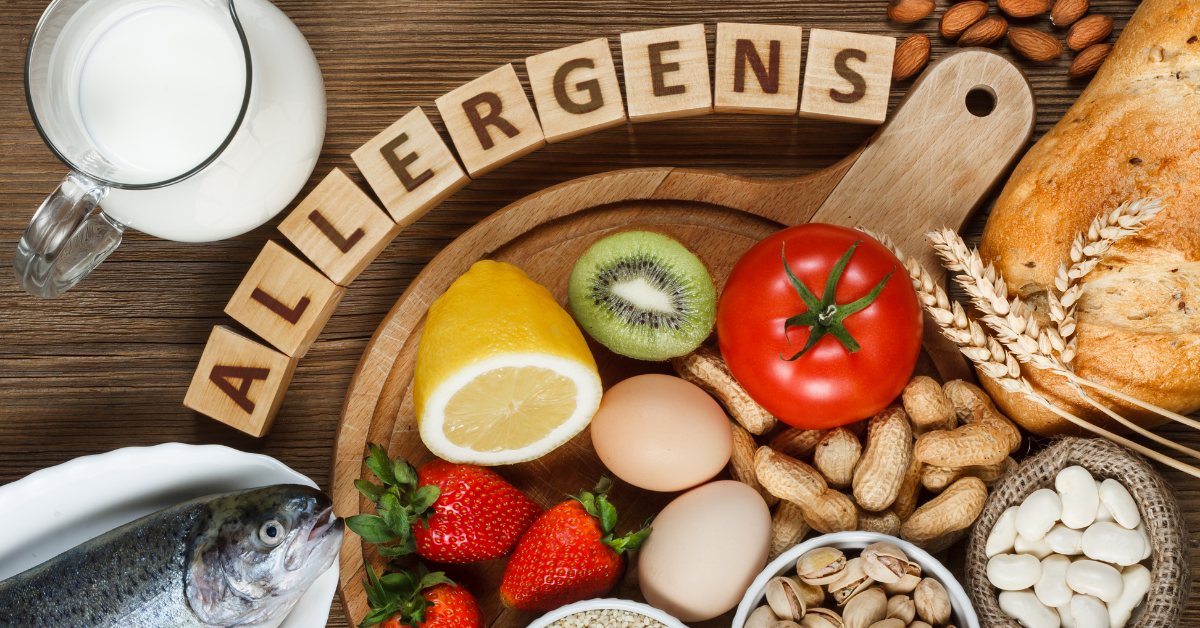Guest post by Alexa Guelig
Food Allergies vs. Intolerances
These terms are often used interchangeably, but each produces a specific reaction in the body and varies greatly in severity. The reactions from allergens and food intolerances elicit harmful and potentially chronic issues. Continuous consumption of food allergens and/or intolerances forces your body to produce inflammatory responses causing damage and unwanted symptoms. Many conditions are related to allergies and intolerances to foods:
- Chronic fatigue
- Autoimmune disorders
- Learning disabilities such as ADHD
- Acne, eczema, and hives
- Depression and anxiety
- Nutrient deficiency
- Weight gain
- Migraine headaches
- And MORE
It is important to identify certain food triggers and their reaction type to restore your health so you can return to living your best life!
What are Food Allergies?
A food allergy occurs when the body’s immune system overreacts to a specific food protein. Food allergies can be serious and even life-threatening. A food allergy comes from a reaction of the allergen-specific immunoglobulin E antibody that is found in the bloodstream. The most common food allergens in the U.S. include milk, wheat, egg, peanut, tree nuts, soy, fish and shellfish. Reactions to food allergens often include hives, abdominal pain, or in severe cases anaphylaxis.
To confirm a food allergy, it is important to consult with an allergist. Unfortunately, there is no cure for food allergies so the only treatment is avoiding consumption.

What are Food Intolerances?
Food intolerances are not the same as allergies, but it may be hard to differentiate between them because symptoms may be similar. A food intolerance is defined as digestive problems occurring after a certain food is eaten. Onset of symptoms, often nausea, bloating, and diarrhea, typically occur while eating or within a few hours after eating the trigger food. Fatigue is also a common symptom. Intolerances to food are less severe than allergies and are not accompanied by an immune response. Causes of food intolerances vary and often small amounts of an offending food may be consumed without adverse outcomes. Often healthy foods are also culprits of these chronic symptoms.
Common causes include:
- Lack of digestive enzymes to breakdown the food
- Irritable Bowel Syndrome (IBS)
- Food additive sensitivity
- Stress
The most common food intolerances are often common food allergens such as gluten, dairy, soy, and peanuts. Hydrogenated oils, alcohol, added sugars, and even certain vegetables may also be offenders to your symptoms.

An example of an allergy or intolerance can be described in the context of milk. An individual may have an allergic reaction (immunologic response) to cow’s milk because of the milk’s protein, or that individual may be intolerant to milk due to an inability to digest the sugar lactose. The inability to digest lactose is a result of lacking the enzyme lactase that is responsible for breaking down the sugars in milk. The latter is known as lactose intolerance resulting in GI discomfort and not an allergic reaction.
If you experience a reaction or uncomfortable symptoms after consuming a particular food, see your doctor to determine if you have an allergy or intolerance. However, certain food intolerances are hard to distinguish. Often a temporary elimination diet may be prescribed. An elimination diet involves removing foods from your diet that you suspect your body cannot tolerate well. These foods are then later introduced one at a time to pinpoint sensitivities based on reactions or symptoms following consuming that food.
How to Identify Food Triggers?
The following is a list of common food intolerances that should be avoided during an elimination diet:
- Gluten
- Dairy
- Soy
- Corn
- Peanuts
- Citrus fruits
- Hydrogenated oil
- Added sugars
- Alcohol
- Caffeine

*It is important to remember these diets, along with any other diet, are individually specific so foods will vary. Trust your gut (literally) when removing certain foods.
Fortunately these diets are temporary and may only involve short-term avoidance of certain foods. It is suggested to remove suspected foods for 2-3 weeks before reintroduction since symptoms from foods can last for up to several days. The goal is to reduce and alleviate symptoms after eating. If symptoms return after introducing a food item, eliminate the food once again to allow symptoms to clear up. During this time, pay attention to your energy levels, sleep quality and digestive regularity to determine any patterns.
Unlike most fad diets, this time is meant to optimally support your body with nutrient dense foods. Aim to include foods like bone broth, fermented dairy such as yogurt, healthy fats like avocado, coconut based products, high quality protein (think eggs and poultry), and plenty of veggies. This attention to your symptoms and what your diet is composed of allows you to become in tune with your body.
Who Should Do an Elimination Diet?
If you are experiencing discomfort after meals, it may be a good idea to try an elimination diet to alleviate these symptoms. People who struggle with autoimmune disorders, allergies, fatigue and chronic skin issues may also benefit. An elimination diet can also help improve irritable bowel syndrome (IBS), treat leaky gut, clear up your skin, and combat headaches.
An elimination diet may not be beneficial or recommended for people with disordered eating habits and a history of disordered eating. Rather, an elimination diet is a tool to determine food intolerances or allergies by temporarily removing them from your diet and reintroducing them one by one so you can feel your absolute best.
Take action: Start a journal as a food diary and write down how you feel after consuming these foods. This will really come be handy when looking back on your elimination diet to determine patterns. This will help you reach more sound conclusions and allow you to speed the elimination process up.
Image credit: Experience Life
References
- Food allergy vs. food intolerance: What’s the difference? (n.d.). Mayo Clinic. Retrieved May 6, 2021, from https://www.mayoclinic.org/diseases-conditions/food-allergy/expert-answers/food-allergy/faq-20058538
- How to do an elimination diet and why. (2017, July 2). Healthline. https://www.healthline.com/nutrition/elimination-diet
- Levy, J. (2019, March 20). Do An Elimination Diet to Uncover Food Allergies or Sensitivities. Dr. Axe. https://draxe.com/nutrition/elimination-diet/
- Ruggeri, C. (2016, December 12). Food Allergy Symptoms + 6 Ways to Reduce Them. Dr.Axe.com. https://draxe.com/health/food-allergy-symptoms/
- What is a food allergy? | food allergy research & education. (n.d.). Retrieved May 6, 2021, from https://www.foodallergy.org/resources/what-food-allergy
Alexa Guelig is a dietetics student at the University of Wisconsin-Madison.



0 Comments